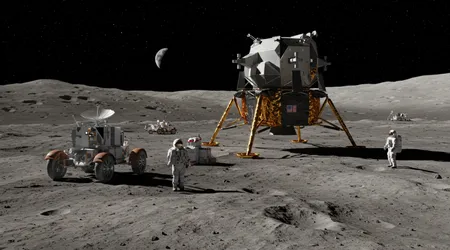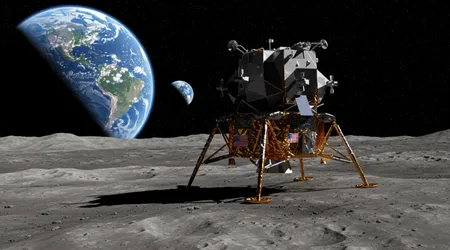What the Artemis Program Could Mean for the Future of Humanity

The Artemis Program, NASA’s ambitious lunar exploration initiative, stands as a beacon of human ingenuity and aspiration in 2025.
Anúncios
It aims to return humans to the Moon by 2027, establish a sustainable presence, and pave the way for Mars missions.
This endeavor transcends mere space travel; it’s a catalyst for scientific breakthroughs, economic growth, and global collaboration.
By targeting the lunar South Pole, rich in water ice, the program promises to unlock resources critical for deep-space exploration.
Why does this matter? Because the Moon is not just a destination it’s a stepping stone to humanity’s cosmic future.
This article explores how the Artemis Program reshapes our trajectory, from technological innovation to philosophical shifts, with real-world implications for generations to come.
A New Era of Scientific Discovery
The lunar South Pole, where Artemis Program missions will land, harbors secrets about our solar system’s origins.
Permanently shadowed craters, like Shackleton, contain frozen water, a resource NASA plans to study. In 2023, NASA’s Lunar Reconnaissance Orbiter confirmed over 600 billion kilograms of water ice in these regions.
This data fuels Artemis III’s mission to collect samples, revealing clues about Earth’s formation. Imagine geologists unearthing a cosmic time capsule each sample could rewrite textbooks.
Beyond water, the Moon’s regolith holds rare minerals like helium-3, a potential fusion energy source. Artemis missions will test extraction techniques, bridging science fiction to reality.
++ The Legacy of Voyager: Humanity’s Most Distant Message
For instance, a single ton of helium-3 could power a city for a year. These experiments could spark clean energy revolutions on Earth, reducing fossil fuel reliance.
The program’s scientific scope extends to astrobiology. By studying lunar volatiles, scientists hope to understand prebiotic chemistry, shedding light on life’s origins.
Artemis II’s 2026 crewed flight will test instruments for these studies, ensuring precision. This isn’t just exploration it’s a quest to answer humanity’s deepest questions.

Economic Transformation Through Lunar Innovation
The Artemis Program ignites a lunar economy, fostering industries that ripple back to Earth. NASA’s Commercial Lunar Payload Services (CLPS) partners with companies like Firefly Aerospace, awarded $176.7 million in 2025 to deliver rovers.
This collaboration reduces costs and spurs private-sector innovation. Think of it like the Gold Rush only the treasure is knowledge and opportunity.
Job creation is another byproduct. The program employs thousands across engineering, manufacturing, and tech sectors.
Also read: How Cold War Tensions Shaped the Race to the Moon
For example, Boeing’s Space Launch System (SLS) production supports over 10,000 jobs in the U.S. alone. These roles, from welders to coders, strengthen economies while building a skilled workforce for future missions.
The lunar marketplace also drives technological spinoffs. Artemis spacesuits, developed by Axiom Space, enhance mobility and radiation protection.
These advancements could improve medical wearables, like exoskeletons for paralyzed patients. By investing in the Moon, we’re seeding innovation that transforms life on Earth.
Moreover, the program’s international partnerships, like Japan’s JAXA contributing to the Lunar Gateway, create global economic synergies.
These collaborations foster trade and shared expertise, amplifying benefits. The lunar economy isn’t a zero-sum game it’s a rising tide lifting all boats.
Read more: SpaceX vs. NASA: A New Era or a Dangerous Privatization?
Building a Sustainable Lunar Presence
Sustainability lies at the heart of the Artemis Program. Artemis Base Camp, planned for the 2030s, will support extended missions using solar power and in-situ resource utilization (ISRU).
Water ice, converted into fuel and oxygen, reduces reliance on Earth’s supplies. Picture a lunar outpost as a self-sufficient Arctic research station, thriving in harsh conditions.
The Lunar Gateway, a space station orbiting the Moon, enhances sustainability. It serves as a staging point for surface missions, equipped with Canada’s Canadarm3 for robotic operations.
By 2028, Gateway will support Artemis IV, enabling reusable infrastructure. This modularity cuts costs and ensures long-term viability.
Environmental stewardship is another focus. The Artemis Accords, signed by 56 nations including Senegal in 2025, promote responsible lunar exploration.
These principles prevent resource overexploitation, preserving the Moon for future generations. It’s a model for ethical space governance.
Additionally, rovers like NASA’s Lunar Terrain Vehicle (LTV), planned for Artemis V, expand exploration range.
They’re designed for durability, minimizing waste. This commitment to sustainability ensures the Moon remains a shared resource, not a plundered frontier.
A Stepping Stone to Mars and Beyond
The Artemis Program is humanity’s proving ground for Mars exploration. Technologies like the SLS rocket, capable of lifting 95 tons to low Earth orbit, are critical for deep-space missions.
Artemis I’s 2022 success validated these systems, setting the stage for crewed flights. Mars missions, targeted for the 2030s, build on this foundation.
The Moon’s low gravity and harsh environment simulate Martian conditions. Artemis III’s 2027 landing will test habitats and life support systems, like Orion’s environmental controls.
These lessons ensure astronauts can survive Mars’ nine-month journey. It’s like training for a marathon by running ultramarathons.
International collaboration, a hallmark of Artemis, extends to Mars. The European Space Agency’s ESPRIT module for Gateway, planned for Artemis V, refines technologies for Martian orbiters.
These partnerships pool resources, accelerating progress toward the Red Planet.
Philosophically, the program shifts our perspective. By mastering lunar living, we embrace our identity as a multi-planetary species.
This mindset prepares us for challenges beyond Mars, like asteroid mining or exoplanet exploration, expanding humanity’s cosmic reach.
Inspiring the Artemis Generation

The cultural impact of the Artemis Program cannot be overstated. It inspires a generation to pursue STEM careers, much like Apollo did in the 1960s.
NASA’s 2024–2025 Artemis ROADS III Challenge engaged over 1,500 students in mission simulations, sparking curiosity. These young minds will lead future innovations.
Representation matters, too. Artemis III aims to land the first woman and person of color on the Moon, breaking barriers.
Astronauts like Christina Koch, a mission specialist for Artemis II, embody this diversity. Their stories resonate, showing anyone can reach the stars.
Public engagement amplifies this inspiration. NASA’s Artemis Real-time Orbit Website (AROW) lets millions track missions, fostering a sense of ownership. Imagine a child in Senegal, a 2025 Accords signatory, dreaming of space this is the program’s legacy.
Artemis also rekindles global unity. By collaborating with nations like Saudi Arabia, which signed an Artemis II CubeSat agreement in 2025, NASA builds bridges. Space exploration becomes a shared human endeavor, transcending borders and conflicts.
Table: Key Artemis Program Milestones (2022–2032)
| Mission | Year | Objective | Key Components |
|---|---|---|---|
| Artemis I | 2022 | Uncrewed lunar orbit | SLS, Orion |
| Artemis II | 2026 | Crewed lunar flyby | SLS, Orion, CubeSats |
| Artemis III | 2027 | Lunar South Pole landing | Starship HLS, Axiom spacesuits |
| Artemis IV | 2028 | Gateway docking | SLS Block 1B, Gateway |
| Artemis V | 2030 | Lunar Terrain Vehicle | ESPRIT, Canadarm3 |
| Artemis VII | 2032 | Foundation Habitat | Mobile Habitat |
Redefining Humanity’s Place in the Cosmos
The Artemis Program challenges us to rethink our role in the universe. It’s not just about planting flags it’s about building a legacy.
By mastering lunar exploration, we gain the confidence to tackle cosmic challenges. What if we could call multiple worlds home? This question drives the program’s vision.
Ethically, Artemis prompts reflection. The Accords emphasize preserving lunar heritage, like Apollo 11’s bootprints.
This respect for history grounds us as we reach for the stars. It’s a reminder that exploration must honor the past while shaping the future.
Finally, the program fosters resilience. Overcoming delays, like Artemis II’s shift to 2026 due to heat shield issues, shows humanity’s tenacity.
Each setback refines our approach, ensuring success. The Artemis Program is a testament to our unrelenting pursuit of the unknown.
Conclusion: A Legacy for Tomorrow
The Artemis Program is more than a series of missions it’s a blueprint for humanity’s future. From unlocking scientific mysteries to sparking economic revolutions, it redefines what’s possible.
Its commitment to sustainability and collaboration sets a precedent for cosmic exploration. As we stand on the cusp of returning to the Moon, the program invites us to dream bigger, work smarter, and unite as a species.
The lunar South Pole awaits, not as an endpoint, but as a launchpad to Mars and beyond. The Artemis Generation, inspired and empowered, will carry this torch, ensuring our place among the stars.
Let’s embrace this journey, for it’s not just about the Moon it’s about who we become along the way.
Frequently Asked Questions
What is the primary goal of the Artemis Program?
The Artemis Program aims to return humans to the Moon, establish a sustainable presence, and prepare for Mars missions, fostering scientific and economic growth.
When will the first crewed Artemis mission launch?
Artemis II, the first crewed mission, is scheduled for April 2026, delayed from 2025 due to technical issues like Orion’s heat shield.
How does the Artemis Program benefit Earth?
It drives innovation, creates jobs, and develops technologies like medical wearables, while fostering international collaboration and inspiring STEM education.
Why focus on the lunar South Pole?
The South Pole’s water ice, confirmed at over 600 billion kilograms, is vital for fuel, oxygen, and sustaining long-term lunar exploration.
What role do international partners play?
Partners like ESA, JAXA, and Canada contribute technologies, such as Gateway’s ESPRIT and Canadarm3, enhancing efficiency and global unity.
